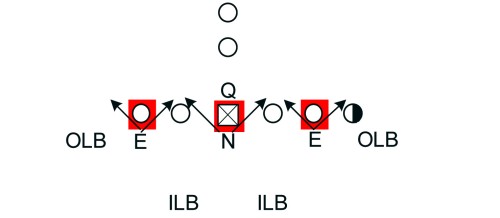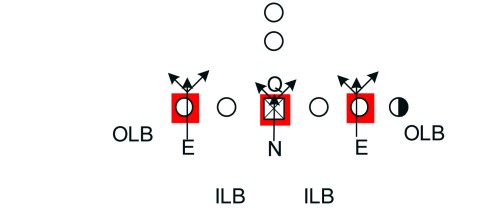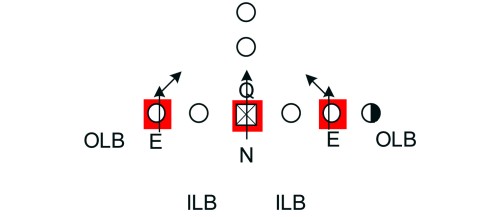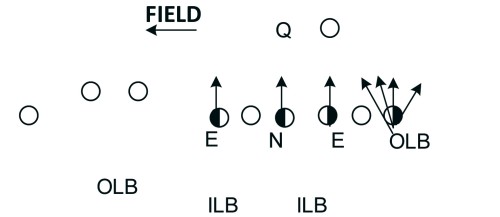3-4 Front with Quarters Coverage: Base Front Variations – These four variations of the 3-4 defense may help your defense with one more player having ‘drop skills.’
by: Travis BurkettSpecial Teams Coordinator/Linebackers Coach • Cornell University ©
More from this issue
Over the past two and a half years of being directly involved with the 3-4 defense and through doing our research, we have encountered several different ways to adjust the base 3-4 look and play a multiple quarters coverage behind it.
Some form of the 3-4 defense is being increasingly implemented at all levels of football. There are many reasons for this but the fundamental premise that our Head Coach Mike Archer and Defensive Coordinator Jared Backus always hangs their hat on is that it allows us to keep one more player with “drop skills” on the field at all times. Our system is multiple but not complicated and simple without being simplistic; through our deployment rules and built-in automatics, our players can play “fast and free” regardless of the variation. No matter what your base set-up, everyone in football defensively must be proficient at a variety of ways to attack. What follows are a few different ways you can use the 3-4 front and be successful.
Any and all of these can be put in for any one season as a way to always play the same coverage and have basically the same run fits while presenting a different appearance to the offense. Equally as important, although these may even look closely similar pre-snap to the offense, how we attack (technique) post-snap can create different issues for the opponent.

1. “50 Front /4-0-4/Slant and Angle/Michigan” (Diagram 1)
This set-up is the old school style of playing a three-man front with two outside linebackers in and around the TE area of the LOS and three defensive linemen completely covering up the two offensive tackles and the center. The three D-linemen all play as tight to the nose of the football as possible and use a 4-point stance so that they move either way to the next gap and man. You can send the slant/angle either way which defines the gaps for the second and third level defenders. The D-linemen are using a 45-degree slant step into the next gap and toward the near trap of the next offensive lineman attempting to create penetration and “knock-off” to eliminate combination blocks on the LOS before they begin.

2. “Jam Front/’FROG’ Stance/4-0-4/Two Gap” (Diagram 2)
This variation has been seen a lot on TV lately, mostly by the Philadelphia Eagles and the University of Oregon. This employs the same set-up as #1 except the three D-linemen are up to 1-yard off of the ball with a stance that calls for their weight to be back on the heels with the hands more underneath the shoulders. It is what some coaches are calling the “frog” stance. This forces the OL to “chase” their combination blocks as the D-linemen come out of their stance on the snap. In addition, the D-linemen can “two gap” their target on the inside half of the two OT’s and the center and allow the LBs to fit to air and make plays off of them. The nose may end up playing either A gap and the two 4 techniques can play either the B or C gaps to their side.

3. “4-0-4/Attack/Double Eagle/B Gap Cancellation” (Diagram 3)
In this style, the nose will play the same exact technique as in variation #2 while the two 4 techniques will change. With this front, one can cancel the A gap cylinder with the nose and the Mike linebacker while declaring that the two 4 techniques will destroy the B areas with their body or the body of the OL which creates a “double eagle” look on the run post-snap. This forces the ball wide. The 4 techniques will align “credit carded” on the neutral zone and play with their inside hand down and inside foot back with an “attack” stance. Their mission is to take the B gap and/or smash the OT or OG through the B gap to the ball. This style can be especially productive against offenses that major in gap/man schemes because it should cancel pullers to both sides.

4. “Under/(Bench/Boundary) Reduction/3 Technique” (Diagram 4)
In this variation, the defense can “set” the front/3 technique any way they want but the base is to set it to the boundary/bench which gives the advantage of allowing the boundary side OLB to essentially play his same technique. This does the same for the nose as he moves from a head-up zero on the center to a slight and heavy shade to the field. This, in essence, transforms the defense into a 4-man front with the boundary OLB being the fourth D-linemen. In addition, it defines the gaps for the LB’s and the entire defense knows where the ball should hit. Using this front can be especially effective against an 11 personnel GUN RUN/PAP operating offense as it allows the pass rushers to start on the edges.
About the Author: Travis Burkett is in his eighth season on the staff of Cornell University, serving as assistant head coach working with the defensive line. He has also coached running backs, tight ends, and linebackers as well as being the special teams coordinator. Burkett spent two seasons as a graduate assistant at Bucknell. He is a 2002 graduate of Saint Mary’s (CA) and played linebacker for the Gaels from 1998-2002.









